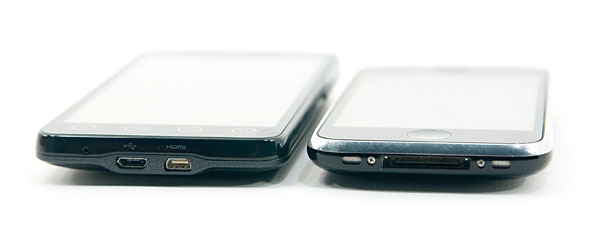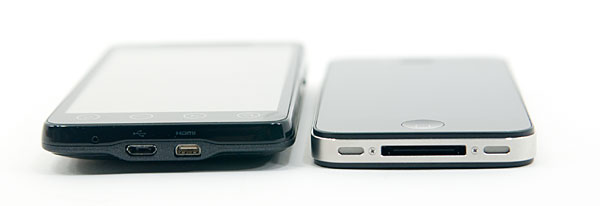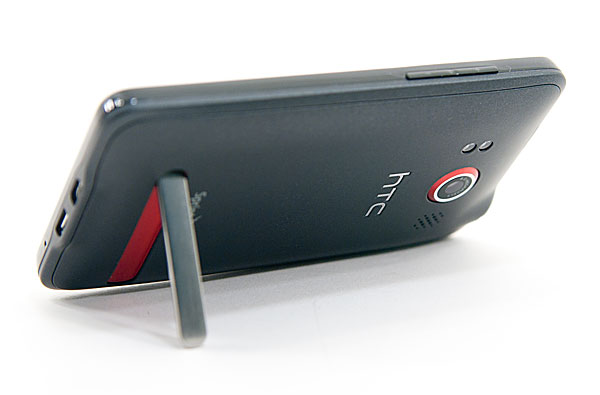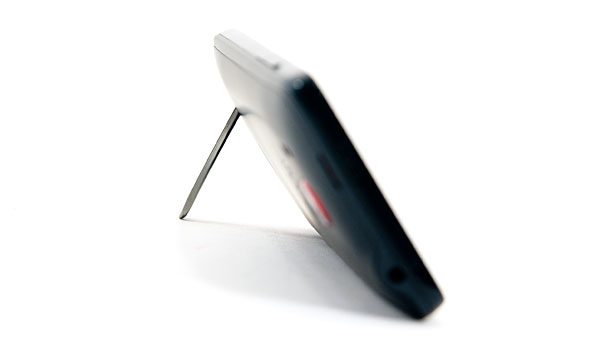The Sprint HTC EVO 4G Review
by Anand Lal Shimpi on June 28, 2010 6:04 PM ESTIt’s really not that big. It seems like it would be based on the specs and photos, but in reality the Sprint EVO 4G by HTC just isn’t that big. And it’s not levied as an insult, I just mean to say that the EVO is manageable in size.
The screen has the same 800 x 480 resolution of the Nexus One and HTC Incredible, but the pixels are spread out over a much larger 4.3” screen. The display setup to be overly red just like the other Android screens we've seen thus far, but it looks great.

The size of the screen is really what sets the EVO 4G apart from the competition, and honestly I couldn’t think of a better phone for browsing the web. Loading full websites is a pleasure and the screen is large enough where you can actually read a lot of content. It's not a tablet replacement, but it is easier to work with than a 3.5 - 3.7" screen.

From left to right: HTC EVO 4G, iPhone 3GS, Nexus One, iPhone 4
I’ve heard it referred to as a mini tablet and honestly I don’t believe that’s the case. The 4.3” screen is big but I’m telling you, it’s not that big in practice. It just ends up feeling like a phone with a good sized screen. Move into the 5” and beyond territory and then you start triggering me calling things tablets.

HTC EVO 4G (left) vs. iPhone 3GS (right)

HTC EVO 4G (left) vs. iPhone 4 (right)
The phone measures 4.8” x 2.6” x 0.5” and it’s the largest smartphone I’ve ever held. That being said, it is absolutely pocketable as long as you’re not wearing skinny jeans. Even then it is thin enough that you could slip it into your back pocket.
| Physical Comparison | |||||||
| HTC EVO 4G (Qualcomm Snapdragon QSD8650) | HTC Droid Incredible (Qualcomm Snapdragon QSD8650) | Apple iPhone 4 | Google Nexus One (Qualcomm Snapdragon QSD8250) | ||||
| Height | 121.9 mm (4.8") | 117.5 mm (4.63") | 115.2 mm (4.5") | 119 mm (4.7") | |||
| Width | 66.0 mm (2.6") | 58.5 mm (2.30") | 58.6 mm (2.31") | 59.8 mm (2.35") | |||
| Depth | 12.7 mm (0.5") | 11.9 mm (0.47") | 9.3 mm ( 0.37") | 11.5 mm (0.45") | |||
| Weight | 170 g (6.0 oz) | 130 g (4.6 oz) | 137 g (4.8 oz) | 130 g (4.6 oz) | |||
| CPU | Qualcomm Scorpion @ 1GHz | Qualcomm Scorpion @ 1GHz | Apple A4 @ ~800MHz | Qualcomm Scorpion @ 1GHz | |||
| GPU | Adreno 200 | Adreno 200 | PowerVR SGX 535 | Adreno 200 | |||
| RAM | 512MB LPDDR1 | 512MB LPDDR1 | 512MB LPDDR1 (?) | 512MB LPDDR1 | |||
| NAND | 8GB micro SD | 8GB micro SD | 16GB or 32GB integrated | micro SD | |||
| Camera | 8MP with dual LED Flash + Front Facing Camera | 8MP with LED Flash | 5MP with LED Flash + Front Facing Camera | 5MP with LED Flash | |||
| Screen | 4.3" 480 x 800 | 3.7" 480 x 800 AMOLED | 3.5" 640 x 960 LED backlit LCD | 3.7" 480 x 800 AMOLED | |||
| Battery | Removable 5.5Whr | Removable 4.81 Whr | Integrated 5.254 Whr | Removable 5.18 Whr | |||
HTC ditched the silly scroll ball of the Nexus One and the optical sensor of the Incredible and just left the EVO 4G with a row of touch sensitive buttons along the base of the screen. Home, Menu, Back and Search are all you get.
If you need a navigational aid the screen is big enough where HTC was able to include directional arrows on the on-screen keyboard. They are awkward to use at first because you’re not used to them, but afterwards they just make sense. I hardly used the scroll ball/optical trackball of the other Android phones so HTC’s decision to reclaim that real estate makes total sense to me. The screen is used for scrolling, if you need fine tuned movement just rely on the virtual arrow keys. Fine by me.
The touch screen supports haptics, which can be fully disabled. When enabled certain button presses will cause the EVO’s motor to vibrate a bit to confirm the touch. It’s a concession for those who still want some tactile feedback.

The EVO 4G is the first Android phone I’ve used with something interesting on its back: a kickstand. The metal stand lets you prop a horizontally oriented EVO on your desk at around a 45 degree angle. It’s great for watching videos, using as a clock or an alternative to a costly dock.

The stand is actually a nice touch, unfortunately the Android UI doesn’t rotate to landscape mode so it’s only useful within apps that support rotation.
Also on the back is the 8MP camera lens (there’s a 1.3MP camera on the front), two LED lights used as a flash and a speaker for the speakerphone. Along the bottom is a standard USB micro B connector and a micro HDMI (D-connector) video out. The HDMI out can only be used to output movies, it won’t mirror your display.

As its name bluntly states, the EVO 4G works on Sprint’s 4G WiMAX network. Sprint’s 4G service is currently only available in 43 cities spread over 15 states, if you find yourself in one of those states then the EVO has more than its large screen to tempt you.
The phone currently sells subsidized for $199 from Sprint after a $100 mail in rebate. Service starts at $69.99 for 450 minutes and unlimited messaging/data and goes all the way up to $134.99 per month including tethering.
| Cost of Ownership Comparison | |||||
| AT&T iPhone 4 | Sprint EVO 4G | Verizon HTC Droid Incredible | |||
| Cost of Device | $199 w/ 2 year contract | $199 w/ 2 year contract after $100 MIR | $199 w/ 2 year contract | ||
| Plan with 900 Minutes, Unlimited SMS/Data | $104.99/mo, unlimited SMS, 2GB data | $99.99/mo, unlimited SMS, unlimited data, 4G | $109.98/mo, unlimited SMS, unlimited data | ||
| Tethering | + $20/mo | + $29.99/mo | + $25/mo* | ||
| Total Monthly + Tethering | $124.99/mo | $129.98/mo | $134.98/mo | ||
| Total Cost of Ownership over 2 Years | $2718.76 | $2598.76 after $100 MIR | $2838.52 | ||
| Total Cost of Ownership over 2 Years w/ Tethering | $3198.76 | $3318.52 after $100 MIR | $3438.52 | ||
Without the mobile hotspot service, the EVO 4G is the most affordable smartphone out of the three majors over the course of two years. AT&T actually offers a better deal with tethering but you need to keep an eye on your usage; go over 2GB per month and you'll incur additional charges, which isn't tough to do if you tether a lot.










97 Comments
View All Comments
Strk - Monday, June 28, 2010 - link
Last I knew, it was free roaming regardless. The minutes is just anytime, which for Sprint is 7am to 7pm (free nights and weekends). But like you said, you get unlimited mobile to mobile regardless of the other person's carrier.I wonder how this thing will stack up against the Samsung Galaxy S phones? I believe all the major carriers are getting one.
ed1112ward - Monday, June 28, 2010 - link
Yup, as a owner of the phone i can confirm then $10 evo tax, err I mean "Premium Data" charge.ChillyPenguin - Monday, June 28, 2010 - link
The 69.99 plan only include 450 minutes to land lines, while it does include unlimited minutes to any cellphone on any network. This review is correct in listing the 900 minute plan as 99.99 including the $10/mo 4G fee. That being said, my wife and I are on a sprint "Simply Everything" 1500 minute shared plan. By the time we get free calling to all cell phones and free nights and weekends, we used less than 300 minutes combined last month.Alexstarfire - Monday, June 28, 2010 - link
It's hard to really compare AT&T prices to Sprint prices since you can't get the exact same plans most of the time. Sprint truly has an "unlimited everything" option while AT&T has a 2GB max limit now. The fact that AT&T ended up being cheaper once tethering is included means little if you go over every month. With 4G and a true unlimited plan it's a pretty safe bet to say that Sprint has a much better plan in place. You can actually use it like it's supposed to be used.I'm very disappointed to hear about the screen in the EVO. A TFT, really? Why sully a great device with a craptastic screen? Not that the screen can't look good, but it'll never look as good as an AMOLED.
And I agree with another person on here that this topic needs to be revisited with Froyo on the device. Would also be worth noting if there is a difference between stock and a "formatted" phone so-to-speak. It would suck to see a stock phone behaving like most stock laptops, but it's still something I'd like to know.
solipsism - Monday, June 28, 2010 - link
In some areas, sure. Like display size, aspect ratio and the built in kickstand. But I would argue the EVO 4G loses that title by having a worse panel type and dot pitch over the new iPhone 4; and, most importantly, such a short playback time whist in Airplane Mode.PS: To extend your entertainment needs one can continuously charge their smartphone from their laptop if on a long flight without access to power. You should be able to get at least 4 charges out of the average notebook.
DigitalFreak - Monday, June 28, 2010 - link
I'm waiting to see how the Droid X pans out. Unfortunately, Verizon is quite a bit more expensive than Sprint, and they don't have any "4G" options. Never been a fan of HTC either.Zebo - Tuesday, June 29, 2010 - link
Great review Anand. Good things come to those who wait, right.:PEvo is a non starter for me since I spend at hours on the phone each day and in the field and battery life kills it in addition to poor screen outside.
Looking forward to iPhone review on battery life and outdoor capability.:)
fifoloveritas - Monday, June 28, 2010 - link
The 30 charge is for wireless hotspot, which is not available on iPhone. Not sure if it's available on any other phone. There's no charge for regular tethering, phone has Share Connection option when it is plugged into USB.Mr Perfect - Monday, June 28, 2010 - link
Anand,I've noticed that the majority of articles on the site lately have been for phones, consoles, laptops and other pre-assembled consumer electronics. Is this the new focus of AT? Has there simply been a dry spell of PC components?
Thanks,
MP
Anand Lal Shimpi - Monday, June 28, 2010 - link
I've got a stack of SSDs here that need work and we'll have new GPUs coming very soon. The smartphones are hot right now but we'll see things come and go in waves. If there's a demand for us to review it, we will :)Take care,
Anand